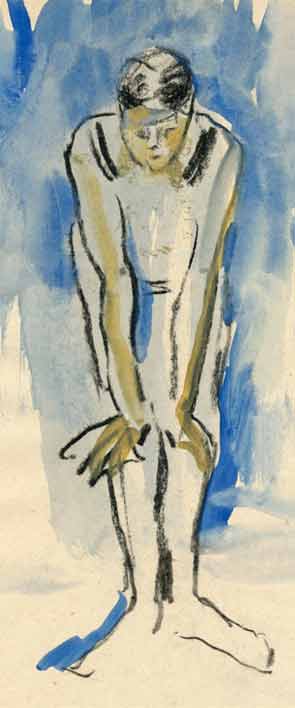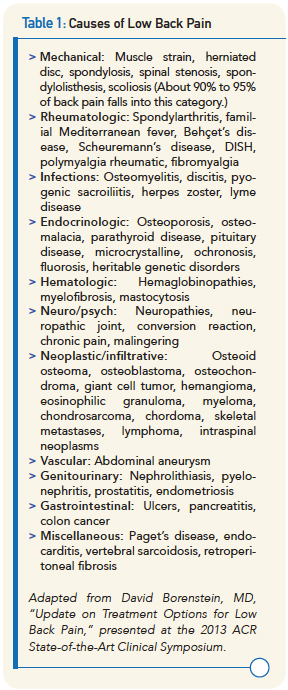
Low back pain is a symptom associated with about 60 different problems that range from muscle strains to spondyloarthritis to osteomyelitis. In a presentation at the 2013 ACR State-of-the-Art Clinical Symposium, held April 20–21 in Chicago, David Borenstein, MD, said that low back pain is challenging for physicians, given the multiple therapies available, the differences between acute and chronic pain, the conflicting research about the effectiveness of the therapies, and the time often required to find an adequate solution for chronic pain.
“Most of us don’t believe that we take care of pain and think that we only take care of the immune system. But, in fact, we do take care of pain, and it is an important part of our job as rheumatologists,” he said. There is little consensus among experts about the definition of low back pain, the differences between chronic and acute low back pain, or how research studies should be designed, said Dr. Borenstein, clinical professor of medicine at the George Washington University Medical Center in Washington, D.C. There is consensus, however, that no single therapy is adequate to treat all chronic pain.
In describing therapy for an average patient with chronic low back pain, Dr. Borenstein said he would treat the patient with several nonpharmacologic therapies, including exercise with range of motion and walking on a treadmill. Patients who smoke are encouraged to stop, and those not sleeping well are advised to cut back on their caffeine consumption. A change in job responsibilities may help patients reduce stress. Over the course of therapy, Dr. Borenstein said that he might prescribe a nonsteroidal antiinflammatory drug (NSAID), an opioid, an antidepressant to increase serotonin production, a topical agent, or a muscle relaxant.
“We need to use multiple categories of therapy at lower doses to maximize the effect and limit the toxicity. Chronic is, in fact, for a long time and there will be ups and downs, but as their physician, you need to keep trying.”
Dr. Borenstein said he classifies low back pain into several groups that represent the causes of the pain (see Table 1). “This is a way of taking those 60 different illnesses and trying to approach them in a thoughtful manner both diagnostically and therapeutically to deal with these various types of medical problems that come into your office.”

Epidural Injections
Dr. Borenstein highlighted recent research examining the efficacy of epidural injections for sciatic pain. One study compared pain relief provided by injections of steroids, saline, or etanercept in 84 adults.1 Steroid therapy gave greater reduction in pain, with 75% of patients in that group reporting 50% or better pain relief at one month, compared with 50% of patients in the saline group and 42% in the etanercept group. “This suggests that modest short-term pain relief is possible with epidurals,” Dr. Borenstein said.
Another study evaluated epidural corticosteroids for spinal stenosis in a retrospective subgroup analysis.2 There was no improvement in outcome with an epidural steroid injection, whether patients were treated surgically or nonsurgically. The injections were associated with significantly less improvement at four years among all patients, as well as longer duration of surgery and a longer hospital stay.
Dr. Borenstein noted that additional research is needed to determine the efficacy of epidural injections for spinal stenosis and herniated discs. “I don’t think we have the final answer, but we have to think about it in this older population, about whether doing this corticosteroid injection is, in fact, in their best interest.”
A number of studies have examined whether an artificial disc could be as effective as fusion or nonoperative therapies. Although some research has indicated that patients have a good outcome over a two-year period, the results have been no better long term than nonsurgical therapy, Dr. Borenstein said. There are several contraindications to disc replacement and potential toxicities.
Nonsurgical Therapies for Back Pain
Dr. Borenstein reviewed current information about the efficacy of several nonsurgical therapies for low back pain:
- Exercise: Although there are multiple forms of exercise, exercise in general has been associated with pain relief and improved function in a number of large studies.
- Massage: Massage therapy is passive therapy, but it has been associated with pain reduction and improved function, and “patients love it,” Dr. Borenstein said.
- Acupuncture: Some experts argue that this may be a placebo-type therapy, but a number of studies have found an association between acupuncture and pain relief and improved function.
- Back schools: Providing patients with education about the anatomy of the back, biomechanics, optimal posture, ergonomics, and exercise can have significant value, particularly when the instruction is conducted in an occupational setting.
- Cognitive behavioral therapy: This type of therapy can provide short-term significant pain relief for patients with fibromyalgia or chronic back pain, but the effectiveness is relatively mild and there are limited options available for this type of therapy.
- Spinal manipulation: The effect is relatively mild to none, with no benefit when compared with sham therapy.
- Transcutaneous electrical nerve stimulation (TENS): The effectiveness has not been determined. One randomized controlled trial found that TENS provided better pain relief than placebo; another found no improvement.
- Lumbar corsets: No studies have compared this therapy with sham therapies. One trial identified an adverse effect with lumbar corsets due to weakening of the paraspinal muscles. Lumbar corsets should be used for only a short period of time in specialized groups.
Kathy Holliman is a medical journalist based in New Jersey.
References
- Cohen SP, While RL, Kurihara C, et al. Epidural steroids, etanercept, or saline in subacute sciatica: A multicenter, randomized trial. Ann Intern Med. 2012;156:551-559.
- Radcliff K, Kepler C, Hilibrand A, et al. Epidural steroid injections are associated with less improvement in patients with lumbar spinal stenosis: A subgroup analysis of the Spine Patient Outcomes Research Trial. Spine. 2013;38:279-291.
